SDTEST® has 38 different VUCA polls that calculate the 13,643 correlation values between stages of development according to the theory of Spiral Dynamics and answer options of these 38 polls.
We invite curiosity about the systemic mechanisms behind this correlation. There may be hidden variables that provide alternative explanations.
-0.4957 (Pearson) between the Practice mindfulness (Great Britain, 2 languages) and the Purple stage.
The critical value of the correlation coefficient for a non-normal distribution, by Spearman, is r = 0.1089. Nevertheless, this negative linear correlation of -0.4957 meets the reliability criteria but does not necessarily imply causation.
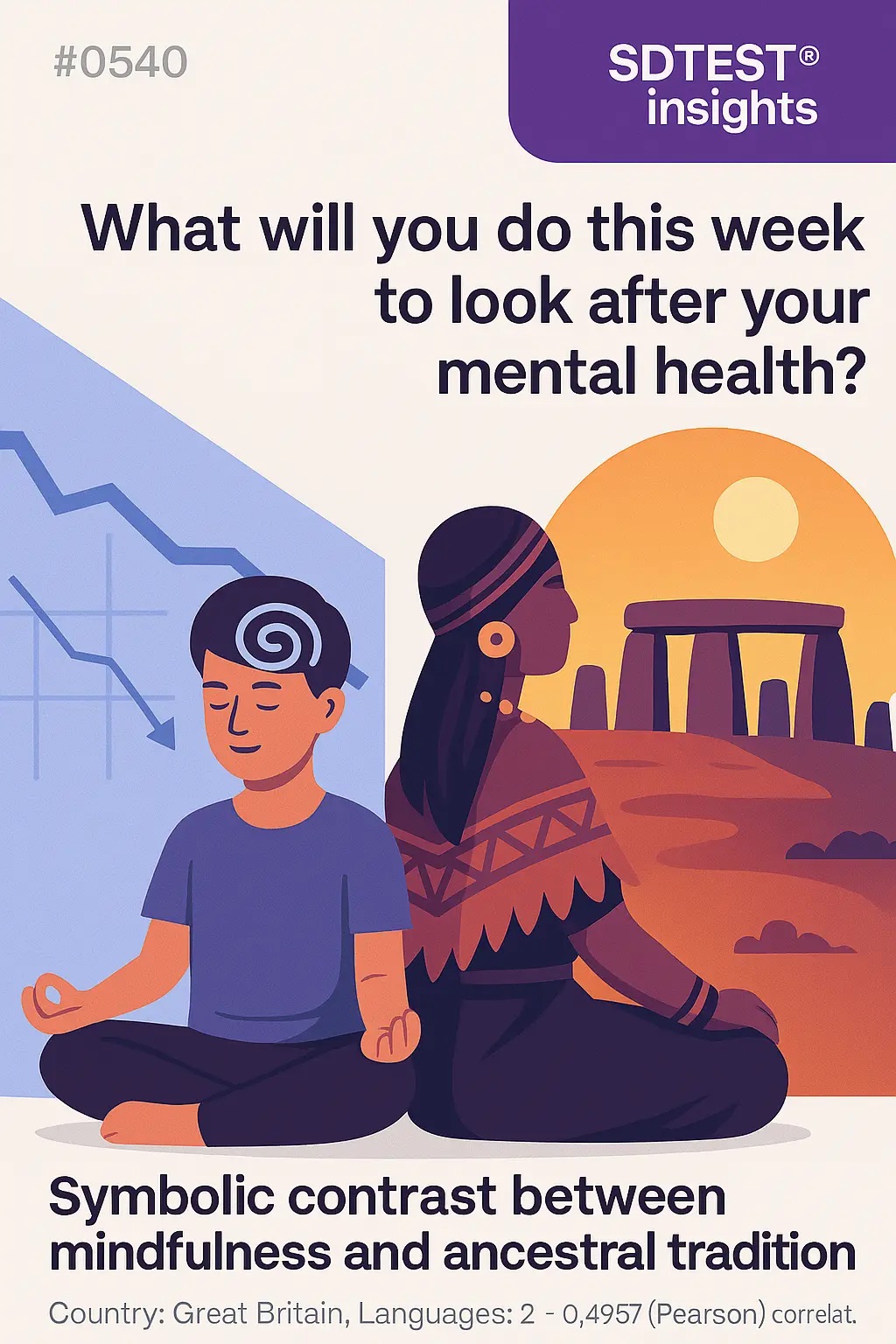
This negative correlation of -0.4957 between Practice mindfulness (Great Britain, 2 languages) and the Purple stage offers intriguing insights when viewed through the lens of the Purple value system's traditional and community-centered worldview:
Organizational Perspective:
Organizations operating within the Purple mindset might interpret this correlation as:
- Validation of their reliance on established traditions and ancestral wisdom rather than modern individual practices like mindfulness
- Confirmation that their emphasis on collective rituals and community-based healing approaches are more effective than solitary mindfulness practices
- Evidence supporting their belief that mental wellbeing comes through connection to sacred traditions and spiritual leaders rather than individual meditation techniques
These organizations might respond by:
- Reinforcing traditional ceremonial practices and group rituals that have been passed down through generations for mental and spiritual wellbeing
- Seeking guidance from respected elders and spiritual authorities rather than adopting contemporary mindfulness approaches
- Implementing collective prayer, storytelling, or ancestral honoring practices as alternatives to individual mindfulness training
Team Perspective:
Teams operating from a Purple mindset might approach this correlation by:
- Viewing it as an affirmation of their preference for group-based spiritual practices over individual mindfulness exercises
- Interpreting it as support for their belief that team cohesion comes through shared rituals and traditions rather than personal meditation
- Seeing it as validation for maintaining ancestral customs and avoiding foreign or modern practices that might disrupt team harmony
These teams might respond by:
- Organizing collective ceremonies, seasonal celebrations, or traditional healing circles for team mental health support
- Consulting with tribal elders or spiritual guides to determine appropriate group practices for well-being
- Rejecting mindfulness as an individualistic practice that could weaken the sacred bonds of community interdependence
Individual Perspective:
Individuals aligned with the Purple value system might interpret this correlation as:
- Personal validation of their trust in ancestral wisdom and traditional healing methods over modern mindfulness techniques
- Evidence supporting their belief that mental health comes through connection to the tribe and spiritual realm rather than individual practice
- Confirmation that following the sacred customs of their forebears provides better protection than unfamiliar meditation practices
These individuals might respond by:
- Seeking support from community elders, shamans, or spiritual leaders rather than practicing solo mindfulness
- Engaging in traditional prayer, ritual cleansing, or ancestral communion for mental wellbeing
- Avoiding mindfulness practices that feel disconnected from their cultural heritage and spiritual beliefs
This correlation, viewed through the Purple lens, suggests that those operating at the Purple level may be resistant to individual mindfulness practices that lack connection to their traditional spiritual framework. It implies that the Purple value system's emphasis on community bonds, ancestral wisdom, and supernatural guidance conflicts with the individualistic nature of modern mindfulness approaches.
The reasons why practicing mindfulness might not appeal to those in the Purple stage in Great Britain could include:
- Ancestral Wisdom: Traditional healing methods passed down through generations are viewed as more trustworthy than modern individual practices
- Community Connection: Mental wellbeing is seen as emerging from tribal bonds and collective rituals rather than solitary meditation
- Spiritual Authority: Guidance from respected elders or supernatural forces is preferred over self-directed mindfulness techniques
- Cultural Preservation: Mindfulness may be viewed as a foreign practice that threatens traditional British or Celtic spiritual customs
- Sacred Taboos: Individual meditation practices might conflict with established religious or cultural prohibitions about spiritual engagement
This correlation prompts us to consider how traditional value systems influence attitudes toward contemporary mental health practices. It raises questions about the importance of cultural context and community-based approaches to wellbeing in Purple-dominant environments.
Ultimately, this correlation underscores the intricate interplay between cultural heritage, spiritual beliefs, and contemporary wellness approaches. Mental health support in Purple contexts may require honoring traditional community-based healing methods rather than individual mindfulness practices.
-0.0763 (Pearson) between the Inspiring and the Red stage.
The critical value of the correlation coefficient for a non-normal distribution, by Spearman, is r = 0.0015. Nevertheless, this negative linear correlation of -0.0763 meets the reliability criteria but does not necessarily imply causation.
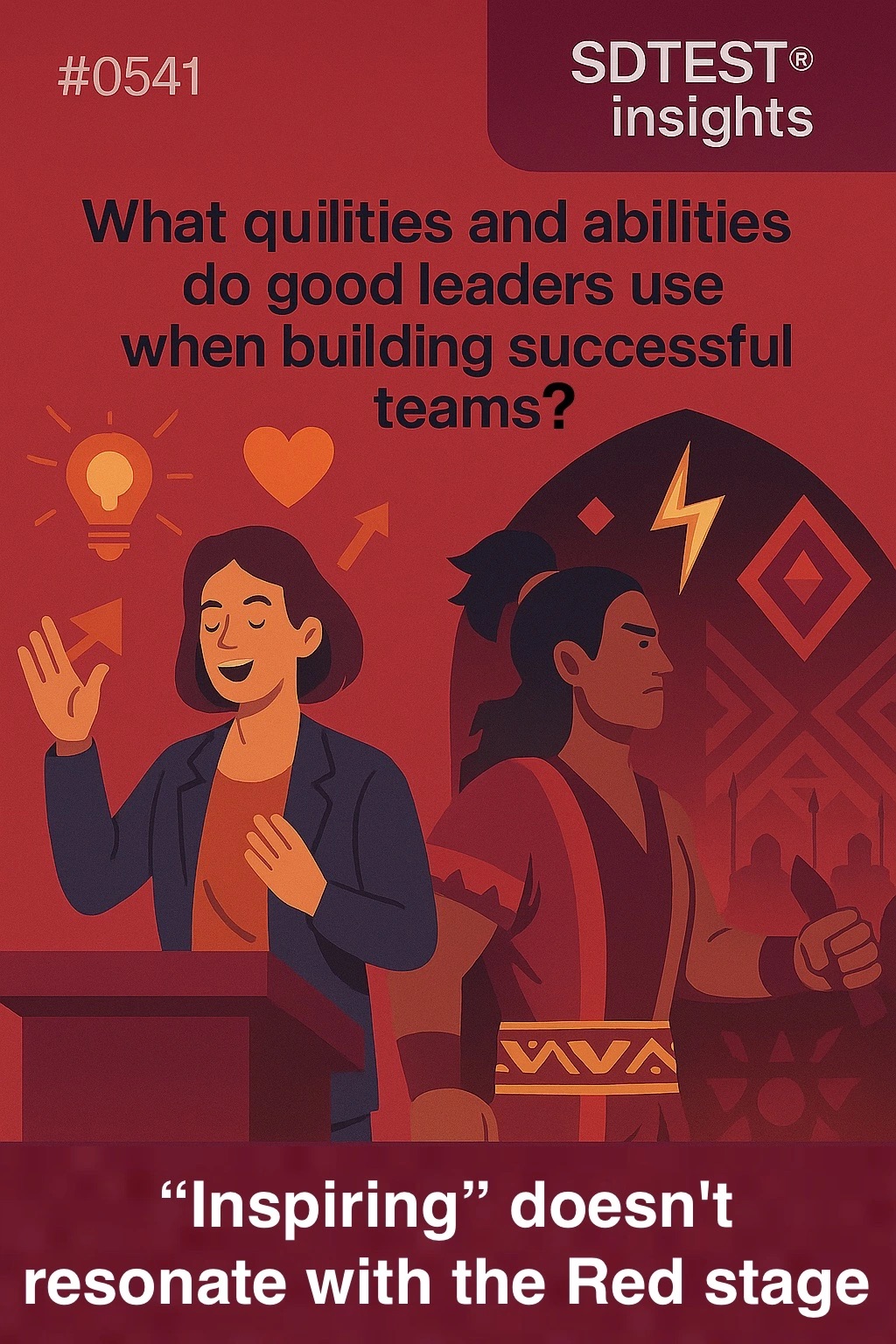
This negative correlation of -0.0763 between Inspiring as a leadership quality and the Red stage offers intriguing insights when viewed through the lens of the Red value system's power-driven and individualistic worldview:
Organizational Perspective:
Organizations operating within the Red mindset might interpret this correlation as:
- Validation of their direct, force-based approach to leadership that prioritizes immediate results over inspirational motivation
- Confirmation that their command-and-control structures are more effective than inspirational leadership styles that rely on emotional appeal
- Evidence supporting their belief that raw power and dominance create more successful teams than inspirational vision-casting
These organizations might respond by:
- Implementing leadership structures that emphasize authority, control, and immediate compliance rather than inspirational messaging
- Rewarding leaders who can impose their will and achieve quick results through direct commands and force
- Eliminating inspirational programs and focusing on power-based incentives like fear of consequences or immediate rewards
Team Perspective:
Teams operating from a Red mindset might approach this correlation by:
- Viewing it as an affirmation of their preference for strong, dominating leaders who command through force rather than inspire through vision
- Interpreting it as support for their belief that team success comes from clear power hierarchies and immediate action, not inspirational motivation
- Seeing it as validation for prioritizing tangible, immediate results over abstract inspirational concepts that delay gratification
These teams might respond by:
- Selecting leaders based on their ability to dominate and control rather than their capacity to inspire and motivate
- Rejecting inspirational team-building activities in favor of competitive challenges and power struggles
- Focusing on immediate, concrete objectives rather than long-term inspirational goals that require sustained motivation
Individual Perspective:
Individuals aligned with the Red value system might interpret this correlation as:
- Personal validation of their preference for direct, forceful leadership over inspirational approaches that seem weak or ineffective
- Evidence supporting their belief that true leadership comes from personal power and dominance rather than the ability to inspire others
- Confirmation that their focus on immediate gratification and self-interest is more effective than inspirational leadership that requires patience
These individuals might respond by:
- Asserting their dominance through direct commands and displays of power rather than attempting to inspire team members
- Viewing inspirational leadership as manipulation or weakness that undermines their authentic self-expression
- Prioritizing their own immediate needs and desires over the long-term inspirational development of team members
This correlation, viewed through the Red lens, suggests that those operating at the Red level may perceive inspirational leadership as ineffective or even counterproductive to their power-driven approach. It implies that the Red value system's emphasis on immediate gratification, dominance, and self-centered action conflicts with the patient, vision-focused nature of inspirational leadership.
The reasons why Inspiring might not be valued as a leadership quality in the Red stage could include:
- Immediate Action: Red leaders prefer direct commands that produce instant results rather than inspirational messages that require time to take effect
- Power Assertion: Inspiring others is seen as unnecessary when raw power and dominance can achieve the same outcomes more quickly
- Self-Focus: Red individuals are primarily concerned with their own needs and desires, making the other-focused nature of inspiration feel unnatural
- Weakness Perception: Inspirational leadership may be viewed as soft or weak compared to the aggressive, forceful approach, Red values
- Manipulation Avoidance: Red's authentic self-expression conflicts with inspirational techniques that might feel like emotional manipulation
This correlation prompts us to consider how different value systems influence leadership preferences and team dynamics. It raises questions about the effectiveness of inspirational leadership approaches in environments where immediate power and results are prioritized.
Ultimately, this correlation highlights the complex relationship between leadership styles and cultural values. It suggests that in Red-dominant contexts, successful team building may require direct, power-based approaches rather than inspirational leadership methods.
In our analysis of the poll "What makes people successful at work?", we found an intriguing positive (linear/nonlinear) correlation that warrants closer examination:
0.3025 (Pearson) between the Willingness to learn (Poland, 3 languages - not Polish) and the Blue stage.
The critical value of the correlation coefficient for a normal distribution, by William Sealy Gosset (Student), is r = 0.2937. Nevertheless, this positive linear correlation of 0.3025 meets the reliability criteria but does not necessarily imply causation.
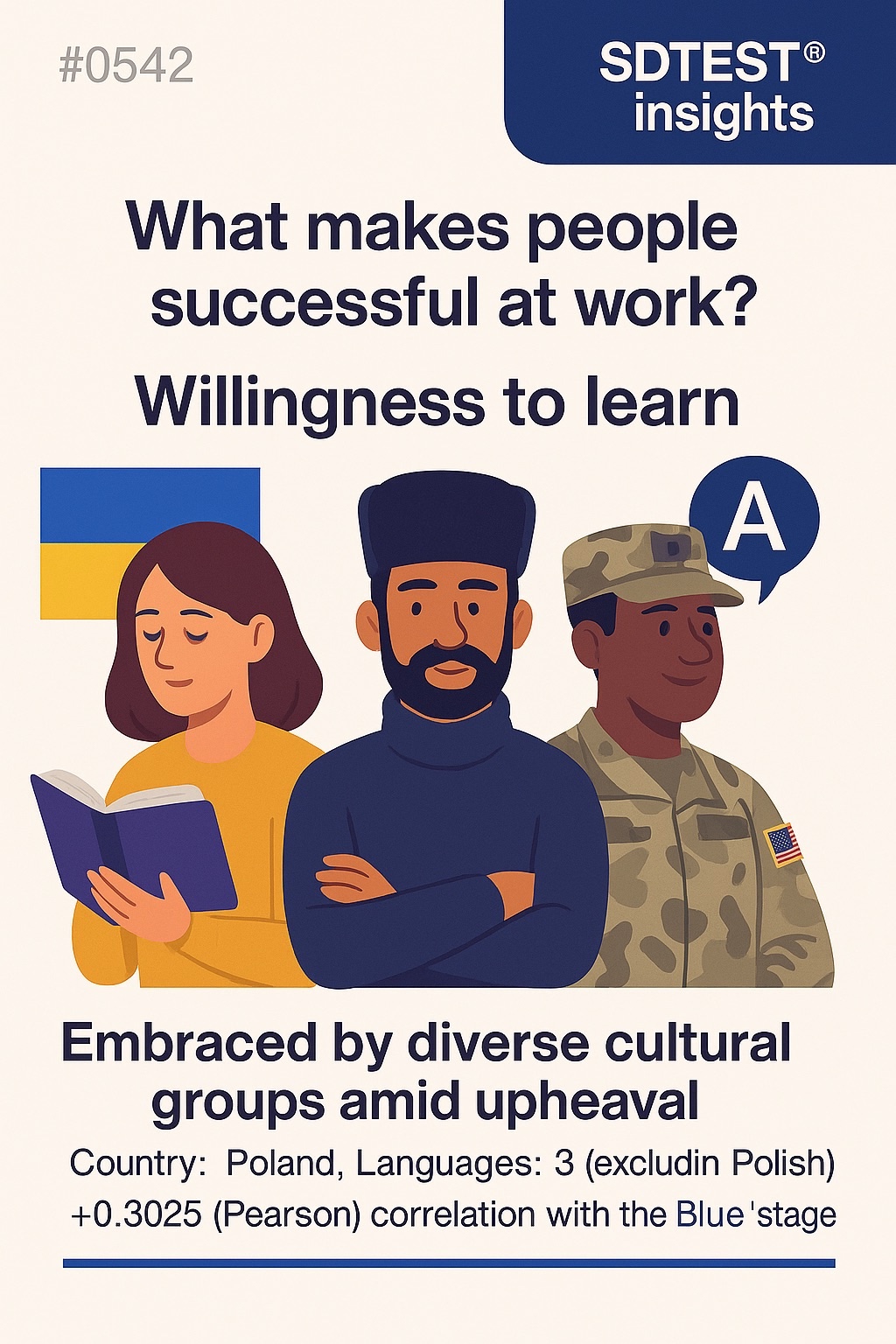
This positive correlation of 0.3025 between Willingness to learn (Poland, 3 languages - not Polish) and the Blue stage offers intriguing insights when viewed through the lens of the Blue value system's order-based and hierarchical worldview:
Organizational Perspective:
Organizations operating within the Blue mindset might interpret this correlation as:
- Validation of their structured approach to integrating non-Polish speakers through formal learning protocols and hierarchical adaptation systems
- Confirmation that their emphasis on disciplined skill acquisition and rule-based professional development creates successful workplace integration
- Evidence supporting their belief that systematic learning within established organizational frameworks produces reliable workforce outcomes
These organizations might respond by:
- Implementing formal training programs with clear progression stages and certification requirements for non-Polish speaking employees
- Establishing mentorship hierarchies where experienced Polish staff guide newcomers through proper workplace protocols and cultural norms
- Creating standardized learning pathways that ensure all employees, regardless of origin, conform to established organizational procedures and values
Team Perspective:
Teams operating from a Blue mindset might approach this correlation by:
- Viewing it as an affirmation of their structured approach to team integration that requires non-Polish speakers to demonstrate commitment through formal learning
- Interpreting it as support for their belief that team success depends on everyone following established protocols and showing dedication to improvement
- Seeing it as validation for their emphasis on duty-based learning, where team members must prove their worthiness through disciplined skill development
These teams might respond by:
- Establishing clear learning objectives and performance standards that non-Polish speakers must meet to gain full team acceptance
- Creating formal peer-review systems where team members monitor and evaluate each other's learning progress according to established criteria
- Implementing traditional apprenticeship models where newcomers must demonstrate respect for hierarchy and commitment to mastering team procedures
Individual Perspective:
Individuals aligned with the Blue value system might interpret this correlation as:
- Personal validation of their belief that success comes through disciplined adherence to learning requirements and respect for established authority
- Evidence supporting their conviction that willingness to learn demonstrates proper moral character and commitment to doing what is right
- Confirmation that following prescribed learning paths and showing deference to Polish workplace traditions leads to righteous success
These individuals might respond by:
- Dedicating themselves to formal language and cultural learning as a moral obligation and demonstration of respect for their host country
- Seeking guidance from established authorities and following traditional learning methods rather than improvised approaches
- Viewing their learning journey as a test of character that requires discipline, patience, and conformity to proper standards
This correlation, viewed through the Blue lens, suggests that those operating at the Blue level may see willingness to learn as a demonstration of proper moral character and respect for established order. It implies that the Blue value system's emphasis on duty, discipline, and hierarchical respect aligns with systematic approaches to workplace integration and success.
The reasons why Willingness to learn might be valued for non-Polish speakers in the Blue stage in modern Poland could include:
- Moral Obligation: Learning is seen as a duty and a demonstration of respect for Polish authority, traditions, and established workplace order
- Hierarchical Integration: Proper learning shows acceptance of the Polish workplace hierarchy and willingness to earn one's place through disciplined effort
- Rule Compliance: Systematic learning ensures non-Polish speakers understand and follow established procedures, regulations, and cultural norms
- Duty Fulfillment: Willingness to learn demonstrates the moral character and work ethic that Blue values require for legitimate success
- Traditional Respect: Learning Polish ways shows proper deference to established cultural authority and time-tested workplace traditions
This correlation prompts us to consider how traditional value systems influence workplace integration in multicultural contexts. It raises questions about the importance of structured learning approaches and hierarchical respect in Blue-dominant professional environments.
Ultimately, this correlation highlights the complex interplay between moral obligation, systematic learning, and workplace success. It suggests that in Blue contexts, non-Polish speakers achieve success by demonstrating proper character through disciplined learning and respect for established authority structures.
In our analysis of the poll "Factors that impact team effectiveness" (by Google), we found an intriguing negative linear correlation that warrants closer examination:
-0.0607 (Pearson) between Psychological safety and the Orange stage.
The critical value of the correlation coefficient for a normal distribution, by William Sealy Gosset (Student), is r = 0.0545. Nevertheless, this negative linear correlation of -0.0607 meets the reliability criteria but does not necessarily imply causation.
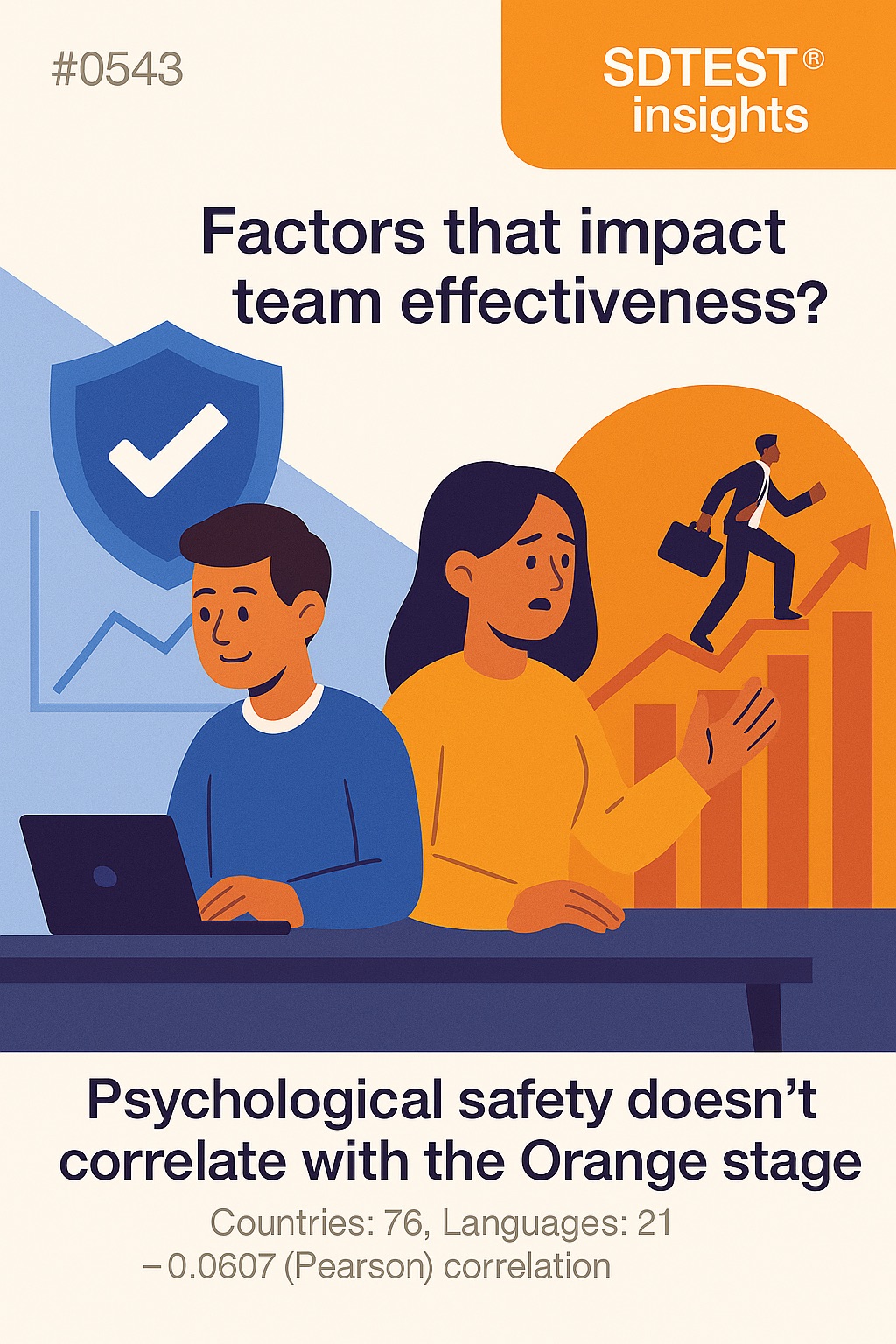
This negative correlation of -0.0607 between Psychological safety and the Orange stage offers intriguing insights when viewed through the lens of the Orange value system's rational, results-driven, and competitive worldview:
Organizational Perspective:
Organizations operating within the Orange mindset might interpret this correlation as:
- Validation of their performance-based approach that prioritizes measurable outcomes and rational decision-making over emotional comfort zones
- Confirmation that their merit-driven, competitive environments produce superior results compared to psychologically "safe" but potentially complacent workplaces
- Evidence supporting their belief that objective data, scientific methods, and logical analysis are more crucial for effectiveness than subjective feelings of safety
These organizations might respond by:
- Implementing rigorous performance metrics and KPI-driven systems that reward results regardless of comfort levels
- Creating competitive environments where the best ideas and solutions emerge through rational debate and evidence-based challenges
- Eliminating "soft" psychological safety initiatives in favor of data-driven feedback systems and objective performance evaluations
Team Perspective:
Teams operating from an Orange mindset might approach this correlation by:
- Viewing it as an affirmation of their results-oriented approach that values logical argumentation and evidence-based decision-making over emotional considerations
- Interpreting it as support for their belief that team effectiveness comes from rational discourse, healthy competition, and objective problem-solving rather than psychological comfort
- Seeing it as validation for their emphasis on individual accountability and merit-based contribution rather than collective emotional well-being
These teams might respond by:
- Establishing performance-driven team cultures where ideas are challenged based on data and logic rather than emotional impact
- Implementing systematic review processes that prioritize analytical rigor and objective assessment over maintaining team members' comfort levels
- Encouraging constructive conflict and debate as necessary tools for reaching optimal, evidence-based solutions
Individual Perspective:
Individuals aligned with the Orange value system might interpret this correlation as:
- Personal validation of their rational, goal-oriented approach that prioritizes competence and achievement over emotional security
- Evidence supporting their belief that professional growth comes through challenging environments that test capabilities rather than protective psychological safety
- Confirmation that their focus on logical analysis, scientific thinking, and objective results is more valuable than subjective emotional considerations
These individuals might respond by:
- Seeking challenging, performance-based environments where their rational capabilities and achievements are objectively evaluated
- Viewing psychological safety as potentially counterproductive to personal growth and professional development
- Prioritizing skill development, knowledge acquisition, and measurable results over team harmony or emotional comfort
This correlation, viewed through the Orange lens, suggests that those operating at the Orange level may perceive psychological safety as less relevant or even counterproductive to achieving optimal team effectiveness. It implies that the Orange value system's emphasis on rational analysis, competitive achievement, and objective results conflicts with the emotionally-focused nature of psychological safety concepts.
The reasons why Psychological safety might not be valued as a factor for team effectiveness in the Orange stage could include:
- Rational Focus: Orange prioritizes logical analysis and evidence-based decision-making over emotional considerations that psychological safety emphasizes
- Performance Orientation: Team effectiveness is measured through objective metrics and results rather than subjective feelings of safety or comfort
- Competitive Advantage: Challenging, competitive environments are seen as more conducive to innovation and excellence than psychologically safe spaces
- Individual Merit: Orange values personal accountability and competence-based contribution over collective emotional well-being
- Scientific Skepticism: Psychological safety concepts may be viewed as unscientific or unmeasurable compared to concrete performance indicators
This correlation prompts us to consider how different value systems influence perceptions of effective team dynamics. It raises questions about the potential trade-offs between emotional comfort and rational performance optimization in Orange-dominant environments.
Ultimately, this correlation highlights the complex relationship between cognitive approaches and team effectiveness models. It suggests that in Orange contexts, team success may be better achieved through rational, performance-based systems rather than psychologically safe environments.
In our analysis of the poll "Trust" (by WVS), we found an intriguing positive (linear/nonlinear) correlation that warrants closer examination:
0.1161 (Pearson) between the People you know personally / Trust completely and the Green stage.
The critical value of the correlation coefficient for a normal distribution, by William Sealy Gosset (Student), is r = 0.06. Nevertheless, this positive (linear/nonlinear) correlation of 0.1161 meets the reliability criteria but does not necessarily imply causation.
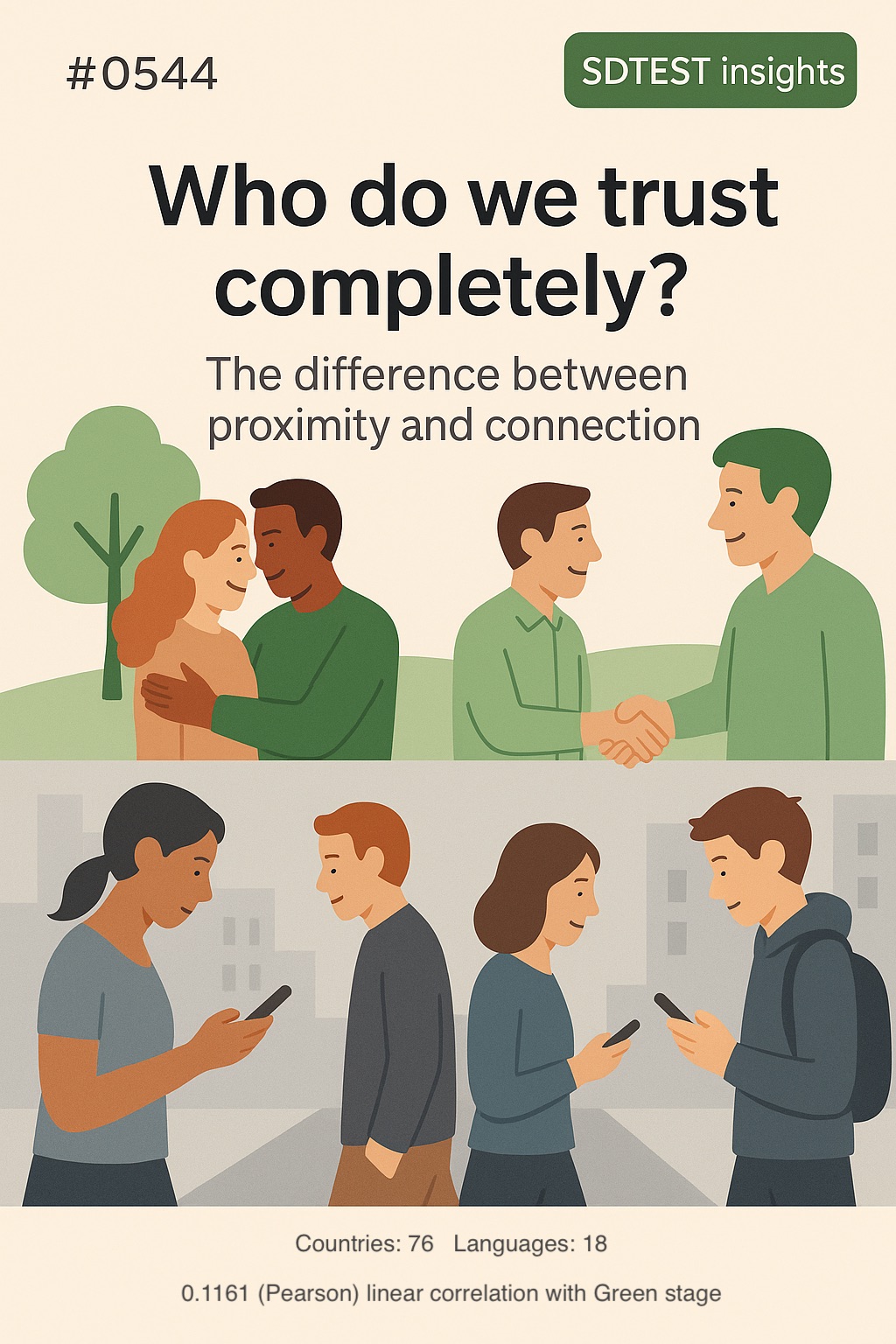
This positive correlation of 0.1161 between Trust completely in people you know personally and the Green stage offers intriguing insights when viewed through the lens of the Green value system's community-focused and holistic worldview:
Organizational Perspective:
Organizations operating within the Green mindset might interpret this correlation as:
- Validation of their relationship-centered approach that prioritizes authentic human connections and personal trust over impersonal corporate structures
- Confirmation that their emphasis on collaborative, consensus-driven decision-making creates deeper organizational bonds based on personal knowing and mutual understanding
- Evidence supporting their belief that sustainable organizational success emerges from genuine human relationships and community-based trust networks
These organizations might respond by:
- Implementing flat organizational structures that facilitate personal relationships and direct human connection across all levels
- Creating extensive opportunities for team members to know each other personally through retreats, storytelling circles, and collaborative projects
- Establishing decision-making processes that rely on personal trust and collective wisdom rather than hierarchical authority or impersonal systems
Team Perspective:
Teams operating from a Green mindset might approach this correlation by:
- Viewing it as an affirmation of their holistic approach to team building that prioritizes deep personal relationships and authentic human connection
- Interpreting it as support for their belief that team effectiveness emerges from genuine care, empathy, and personal understanding among members
- Seeing it as validation for their emphasis on creating safe, inclusive spaces where team members can be vulnerable and build meaningful personal bonds
These teams might respond by:
- Dedicating significant time to personal sharing, relationship building, and creating opportunities for team members to know each other beyond professional roles
- Implementing consensus-based decision-making processes that rely on personal trust and collective agreement rather than formal procedures
- Prioritizing team harmony and personal well-being, ensuring that all members feel personally valued and genuinely cared for by their colleagues
Individual Perspective:
Individuals aligned with the Green value system might interpret this correlation as:
- Personal validation of their deeply relational approach to life that values authentic human connection and genuine personal knowing
- Evidence supporting their belief that true trust can only emerge through personal relationships, shared values, and mutual understanding
- Confirmation of their holistic worldview that sees personal relationships as fundamental to all aspects of human flourishing and social cooperation
These individuals might respond by:
- Investing deeply in personal relationships and taking time to genuinely know and understand the people in their lives
- Prioritizing authentic connection and vulnerable sharing as pathways to building complete trust with others
- Approaching all interactions through a lens of empathy, care, and genuine interest in others' well-being and personal stories
This correlation, viewed through the Green lens, suggests that those operating at the Green level naturally develop complete trust through deep personal relationships and authentic human connection. It implies that the Green value system's emphasis on community, empathy, and holistic understanding creates an environment where personal knowing becomes the foundation for complete trust.
The reasons why People you know personally might receive complete trust in the Green stage could include:
- Authentic Connection: Green values genuine human relationships and personal knowing as the foundation for all meaningful trust and cooperation
- Holistic Understanding: Personal relationships allow for complete understanding of others' values, motivations, and character through direct experience
- Community Emphasis: Green prioritizes community bonds and collective well-being, making personal trust essential for social cohesion and mutual support
- Empathetic Knowing: Deep empathy and emotional intelligence enable Green individuals to truly know and trust others at a personal level
- Shared Values: Personal relationships in Green contexts often involve alignment around common values of sustainability, cooperation, and care for all beings
This correlation prompts us to consider how community-oriented value systems influence trust formation and social relationships. It raises questions about the importance of personal connection and authentic relationships in creating sustainable, cooperative social structures.
Ultimately, this correlation underscores the pivotal role of personal relationships in Fostering Green consciousness. It suggests that in Green contexts, complete trust emerges naturally from genuine human connection, shared values, and authentic personal knowing.
In our analysis of the poll "Empathy is," we found an intriguing negative linear correlation that warrants closer examination:
-0.1414 (Pearson) between the Sensing other people's emotions / Strongly Disagree and the Yellow stage.
The critical value of the correlation coefficient for a normal distribution, by William Sealy Gosset (Student), is r = 0.0615. Nevertheless, this negative linear correlation of -0.1414 meets the reliability criteria but does not necessarily imply causation.
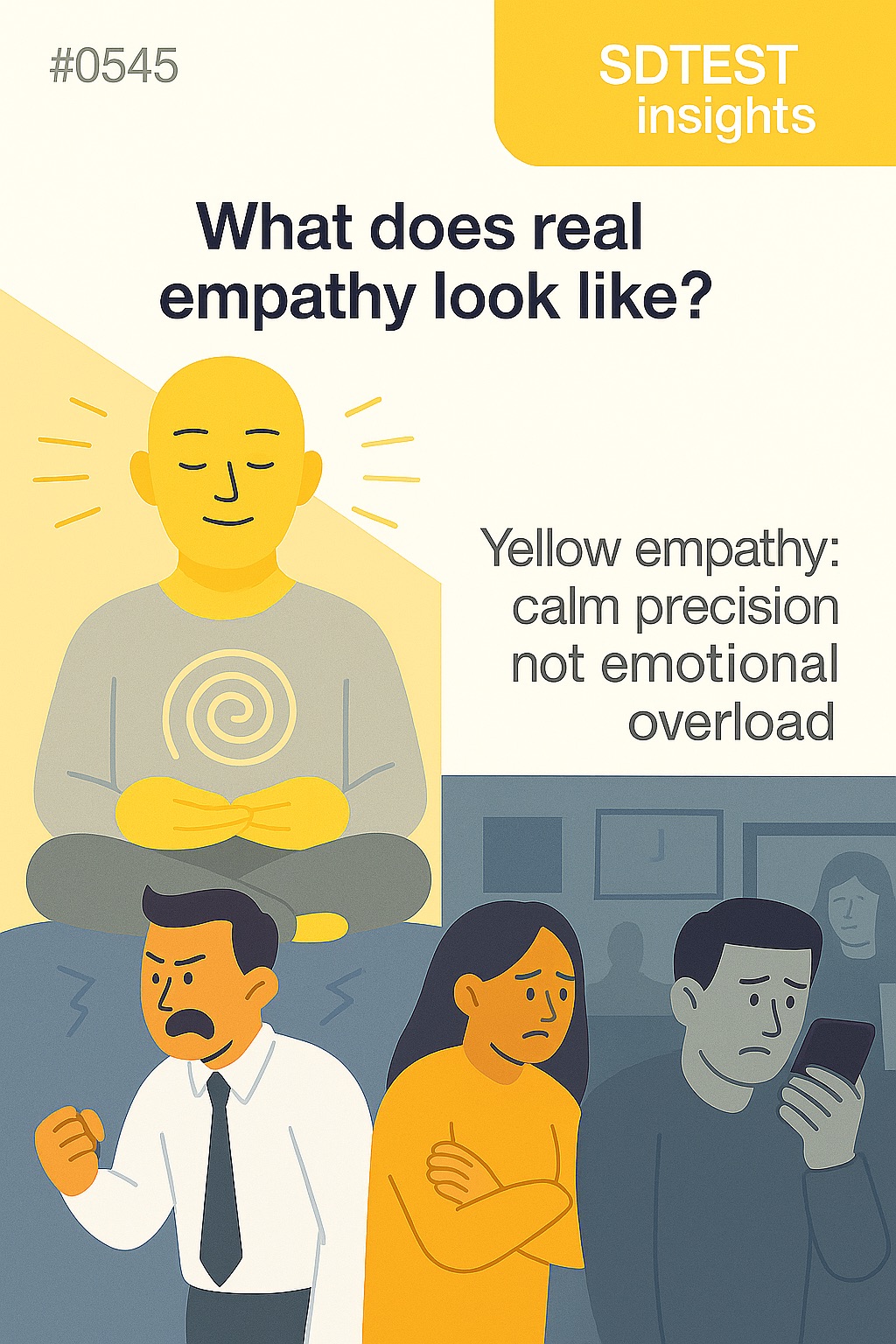
This negative correlation of -0.1414 between Strongly Disagree that empathy is "sensing other people's emotions" and the Yellow stage offers intriguing insights when viewed through the lens of the Yellow value system's integrative and systems-thinking worldview:
Organizational Perspective:
Companies operating within the Yellow mindset might interpret this correlation as:
- Validation of their sophisticated understanding that emotional sensing forms the foundational layer of empathic intelligence within complex organizational systems
- Confirmation that their integrative approach recognizes emotional sensing as the essential first-tier capacity that enables higher-order empathic functions and systemic awareness
- Evidence supporting their belief that effective organizational empathy must begin with accurate emotional detection before advancing to developmental and systemic understanding
These companies might respond by:
- Implementing comprehensive empathy development programs that establish emotional sensing as the foundational skill before advancing to complex perspective-taking
- Creating organizational assessment tools that measure emotional sensing accuracy as a prerequisite for leadership roles requiring advanced empathic capabilities
- Developing training systems that integrate emotional sensing with cognitive empathy and systems awareness as complementary rather than competing capacities
Team Perspective:
Teams operating from a Yellow mindset might approach this correlation by:
- Viewing it as an affirmation of their understanding that emotional sensing provides the essential data foundation for navigating complex team dynamics across multiple value systems
- Interpreting it as support for their belief that accurate emotional perception enables effective integration of diverse perspectives and developmental stages within teams
- Seeing it as validation for their approach that honors emotional sensing as the gateway skill that enables deeper systemic and developmental empathy
These teams might respond by:
- Developing team practices that cultivate refined emotional sensing abilities as the foundation for more complex empathic interactions
- Implementing feedback systems that help team members calibrate their emotional sensing accuracy across different personality types and cultural backgrounds
- Creating team cultures that value emotional sensing as an essential component of the multi-layered empathic intelligence required for high-performance collaboration
Individual Perspective:
Individuals aligned with the Yellow value system might interpret this correlation as:
- Personal validation of their recognition that emotional sensing represents the essential building block upon which more sophisticated empathic capacities are constructed
- Evidence supporting their belief that accurate emotional perception provides the foundational data necessary for effective perspective-taking across value systems
- Confirmation of their integrative approach that sees emotional sensing as the first-tier skill that enables access to higher-order empathic functions
These individuals might respond by:
- Dedicating focused attention to developing highly refined emotional sensing abilities as the foundation for their broader empathic intelligence
- Practicing emotional sensing as a disciplined skill that informs their ability to navigate complex interpersonal and systemic dynamics
- Viewing emotional sensing mastery as essential preparation for the advanced empathic capacities required for effective leadership across developmental stages
This correlation, viewed through the Yellow lens, suggests that those operating at the Yellow level may recognize emotional sensing as the essential foundational capacity that enables all higher-order empathic functions. It implies that the Yellow value system's integrative approach leads to strong agreement with emotional sensing as the fundamental definition of empathy.
The reasons why people might Strongly Agree that empathy is "sensing other people's emotions" in the Yellow stage could include:
- Foundational Recognition: Yellow understands emotional sensing as the essential first-tier capacity that enables all advanced empathic functions and systemic awareness
- Integrative Sequencing: Emotional sensing provides the foundational data necessary for effective perspective-taking across different value systems and developmental stages
- Systems Prerequisite: Accurate emotional perception serves as the essential input for understanding complex interpersonal and organizational dynamics
- Developmental Foundation: Emotional sensing mastery represents the prerequisite skill for advancing to higher-order empathic capacities and integral awareness
- Practical Integration: Yellow recognizes that without accurate emotional sensing, attempts at advanced empathy become theoretical rather than practically effective
This correlation prompts us to consider how integrative consciousness values foundational capacities as essential components of complex systems. It raises questions about the developmental sequencing of empathic abilities across different stages of human development.
Ultimately, this correlation highlights the Yellow system's appreciation for foundational skills within integrated approaches to human understanding. It suggests that in Yellow contexts, emotional sensing is strongly valued as the essential prerequisite for all advanced empathic capabilities.
In our analysis of the poll "The main priorities of job seekers," we found an intriguing positive linear correlation that warrants closer examination:
0.0760 (Pearson) between the Interesting content of the work and the Turquoise stage.
The critical value of the correlation coefficient for a normal distribution, by William Sealy Gosset (Student), is r = 0.0575. Nevertheless, this positive linear correlation of 0.0760 meets the reliability criteria but does not necessarily imply causation.

This positive correlation of 0.0760 between Interesting content of the work and the Turquoise stage offers intriguing insights when viewed through the lens of the Turquoise value system's holistic and interconnected worldview:
Organizational Perspective:
Companies operating within the Turquoise mindset might interpret this correlation as:
- Validation of their purpose-driven approach that integrates meaningful work with planetary and social regeneration, creating naturally engaging content
- Confirmation that their holistic business models, which honor the interconnectedness of human fulfillment and ecological well-being, attract consciousness-aligned talent
- Evidence supporting their belief that interesting work emerges from addressing complex, systemic challenges that contribute to the evolution of both humanity and the natural world
These companies might respond by:
- Designing work content that explicitly connects individual tasks to larger ecological and social systems, making every role inherently meaningful and engaging
- Creating interdisciplinary projects that allow employees to explore the interconnections between their expertise and broader planetary healing initiatives
- Implementing organizational structures that enable employees to engage with complex, evolving challenges rather than repetitive, disconnected tasks
Team Perspective:
Teams operating from a Turquoise mindset might approach this correlation by:
- Viewing it as an affirmation of their integrative approach to work design that weaves together personal growth, collective evolution, and planetary stewardship
- Interpreting it as support for their belief that interesting work naturally emerges when teams address multidimensional challenges that honor both human and ecological systems
- Seeing it as validation for their emphasis on creating work content that engages multiple intelligences and connects to the team's shared purpose of contributing to global healing
These teams might respond by:
- Developing project frameworks that integrate technical expertise with ecological awareness, social impact, and spiritual development
- Creating collaborative processes that allow team members to explore the deeper patterns and connections underlying their work
- Establishing team cultures that celebrate the complexity and interconnectedness of challenges as sources of engagement and growth
Individual Perspective:
Individuals aligned with the Turquoise value system might interpret this correlation as:
- Personal validation of their need for work that honors their holistic understanding of reality and their role in the interconnected web of existence
- Evidence supporting their belief that meaningful work must engage their whole being - intellectual, emotional, spiritual, and ecological dimensions
- Confirmation of their understanding that interesting work naturally emerges when it contributes to the evolution of consciousness and the healing of planetary systems
These individuals might respond by:
- Seeking roles that allow them to engage with complex, systemic challenges that integrate multiple disciplines and perspectives
- Prioritizing work opportunities that contribute to both personal evolution and collective healing of social and ecological systems
- Viewing work content as interesting only when it honors the sacred interconnectedness of all life and contributes to planetary transformation
This correlation, viewed through the Turquoise lens, suggests that those operating at the Turquoise level naturally gravitate toward work content that reflects their holistic understanding of reality and their commitment to integrated solutions. It implies that the Turquoise value system's emphasis on interconnectedness and systemic awareness creates a natural affinity for complex, meaningful work content.
The reasons why Interesting content of the work might be a priority for job seekers in the Turquoise stage could include:
- Systemic Engagement: Turquoise consciousness seeks work that addresses the complex, interconnected challenges facing humanity and the planet
- Holistic Integration: Interesting work content naturally emerges when it engages multiple dimensions of human experience and contributes to collective evolution
- Planetary Purpose: Work becomes inherently engaging when it contributes to the healing and transformation of both human and natural systems
- Consciousness Evolution: Turquoise individuals are drawn to work that facilitates their own growth while contributing to the expansion of collective awareness
- Sacred Interconnection: Work content becomes interesting when it honors the sacred relationships between all aspects of existence
This correlation prompts us to consider how evolved consciousness influences career priorities and work design. It raises questions about the relationship between individual fulfillment and planetary healing in post-conventional career choices.
Ultimately, this correlation highlights the natural alignment between Turquoise consciousness and meaningful work content. It suggests that in Turquoise contexts, interesting work emerges organically when it honors the interconnectedness of personal growth, collective evolution, and planetary stewardship.
What insights do you gain from today's correlation? How might we study this relationship more carefully before deducing causation?
We welcome respectful and wise perspectives! Stay tuned every week as we share more results and insights.
After login or registration, free access to the poll results in the FAQ section.
2025.06.29
FearpersonqualitiesprojectorganizationalstructureRACIresponsibilitymatrixCritical ChainProject Managementfocus factorJiraempathyleadersbossGermanyChinaPolicyUkraineRussiawarvolatilityuncertaintycomplexityambiguityVUCArelocatejobproblemcountryreasongive upobjectivekeyresultmathematicalpsychologyMBTIHR metricsstandardDEIcorrelationriskscoringmodelGame TheoryPrisoner's Dilemma
Valerii Kosenko
Muridzi weChigadzirwa SaaS SDTEST®
Valerii akakodzera sesocial pedagogue-psychologist muna 1993 uye kubvira ipapo akashandisa ruzivo rwake mukutungamira kweprojekiti.
Valerii akawana Master's degree uye chirongwa uye chirongwa chemaneja qualification muna 2013. Panguva yechirongwa chaTenzi wake, akazoziva Project Roadmap (GPM Deutsche Gesellschaft für Projektmanagement e. V.) uye Spiral Dynamics.
Valerii ndiye munyori wekuongorora kusavimbika kweV.U.C.A. pfungwa inoshandisa Spiral Dynamics uye nhamba dzemasvomhu mune zvepfungwa, uye makumi matatu nemasere sarudzo dzepasi rose.








